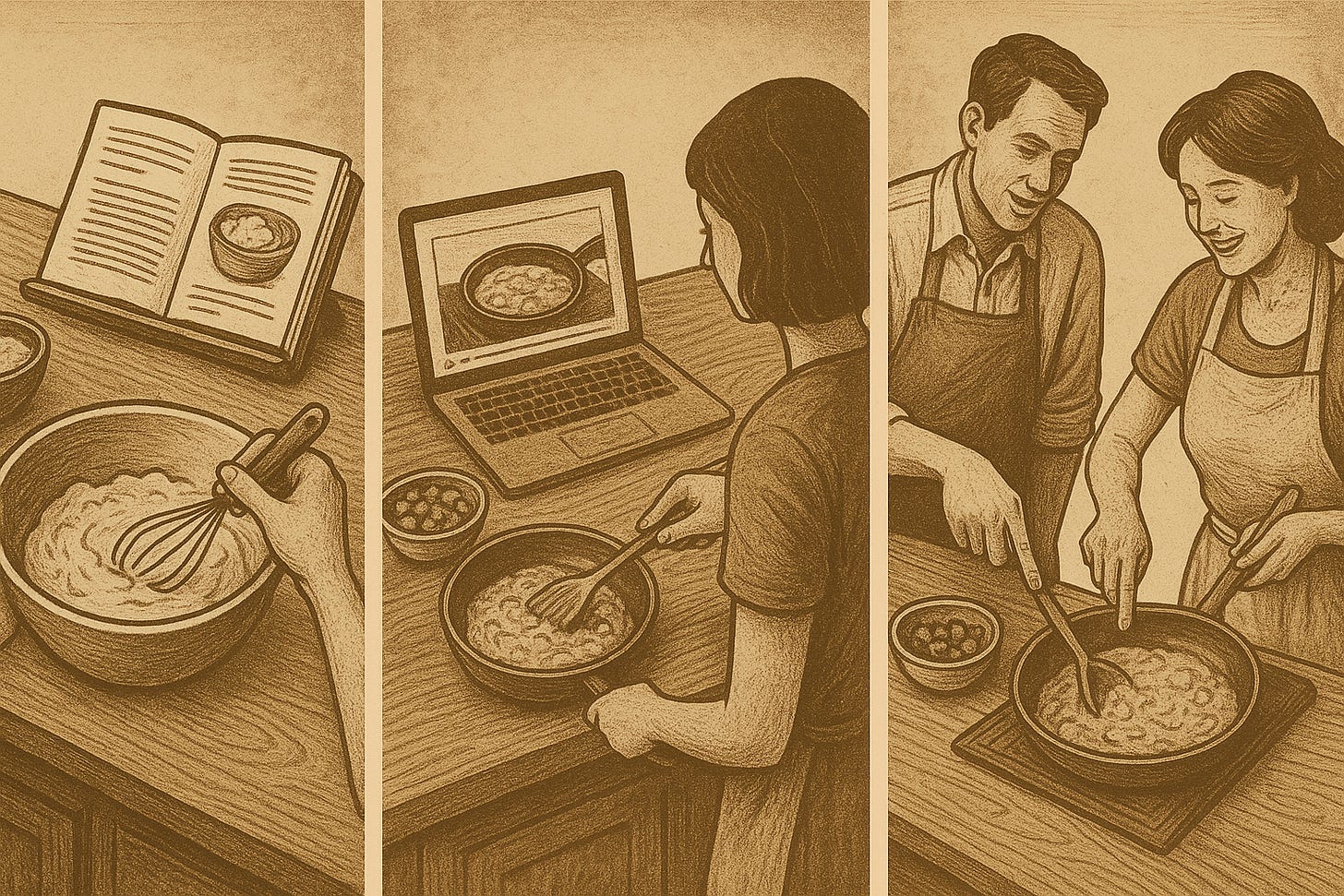Learning writing alone is slowing you down
Interactive learning isn’t a buzzword. It’s the missing ingredient in how family historians learn to write and produce great stories.
Most online courses talk at you.
They hand you lists of “shoulds,” tell you what to do, and leave you to figure out how to make it work for you on your own.
And in the case of writing courses, it’s especially frustrating. I’ve been there — deciding what’s relevant, inventing my own process to go from facts to outline, and guessing how to turn it all into a story. It’s exhausting.
You don’t need more classes and assignments. You need a method you can move through with others.
The biggest myth in education that just won’t die
The biggest myth in education is that there are three ways to learn: visual, auditory, or kinesthetic.
People describe themselves as “visual” or “auditory” learners (no one seems to pick kinesthetic), but those categories were never grounded in solid science. That idea came from 1970s educational pop psychology, not evidence. Decades of research have found no consistent proof that matching instruction to a “learning style” improves outcomes.
The truth: everyone learns best by doing — through active engagement, feedback, and repetition.
The reality of how adults learn
When it comes to learning by doing, there are three ways it happens: observational, imitation, and interactive (De Felice et al., 2022). The best way to understand these is through learning to cook.
Picture this: you’re standing in your kitchen, cookbook open, trying to make something new. The recipe looks simple enough. You measure, stir, and guess whether it’s right. Maybe there’s a photo, but you still don’t know what it’s supposed to taste like. That’s the first way of learning — observational: reading the instructions and trying to figure it out alone.
Then there’s the second way. You pull up a YouTube video, pause after each step, copy what the cook does, and hope your version turns out similar. That’s imitation learning. You’re watching and reproducing, but you still don’t feel what makes the dish come together.
And then there’s the third way. You cook beside someone who’s done it before. You see what they see. You ask questions mid-step. They explain why the sauce thickens, why the order matters, and how to know when you’ve nailed it. That’s interactive learning.
Interactive learning is the way people master new skills and make real progress on what matters to them.
Applying this to genealogy and family history writing
If you’re ready to apply the principles of interactive learning to your own genealogy work, here’s how to do it:
Practice active research sessions: Rather than just reading documents, take notes that connect facts to potential story themes. Ask yourself questions as you work: “What does this reveal about their daily life?” or “How does this challenge what I thought I knew?”
Create iterative drafts: Write rough versions quickly, then revise based on what you learn. Don’t wait for perfect research—start writing with what you have and let the writing reveal gaps in your knowledge.
Use AI as a thinking partner: Engage with AI tools to brainstorm outline variations, generate alternative phrasings, and explore different narrative structures. Treat it as a conversation, not a one-time prompt.
Seek feedback early and often: Share works-in-progress with trusted readers, such as fellow genealogists, writing partners, or family members. Early feedback prevents you from producing something that isn’t interesting to read.
Build a repeatable workflow: Document your process as you discover what works. Create templates, checklists, or frameworks that you can apply to your next family story.
Connect with other family history writers: Join writing groups, cohorts, or communities where you can see others’ progress, share challenges, and celebrate finished stories together.
The key is moving from passive consumption of webinars and online courses of information to active creation with feedback loops built in. That’s when learning sticks—and stories come alive.
It’s the difference between theory and mastery. And it’s what happens inside Chronicle Makers.
What makes Chronicle Makers different
Chronicle Makers uses the science of adult learning and applies teaching genealogy research and family history writing.
In the Chronicle Foundations Writing Cohort, the goal, method, and tools are already built. All those items up there for you to do? They are already set up and waiting for you.
You’re not starting from a pile of instructions. You’re stepping into a shared process designed to get you to one outcome: an awesome finished family story.
When you work alone, perfectionism and doubt creep in. “Is this good enough?” “Am I doing it right?” You second-guess every sentence, hesitate to call something finished, and eventually lose steam.
The cohort structure changes that rhythm. You always know what’s next. You see others finishing, revising, sharing. It builds momentum.
You’re not chasing a grade or approval. You’re building a story that lives and breathes — and you can feel yourself getting better every day.
Ready to join us?
The Chronicle Foundations Writing Cohort starts today. We’ve built in time to catch up, and the schedule is paced for real life — just one to two hours a day.
Perfect for anyone who’s busy, ready to finish a family story, and tired of doing it alone.
You don’t need more learning. You need an interactive method that’s shared, proven, and with people working beside you. That’s what the Chronicle Foundations Writing Cohort offers.
Join us and let’s finish your story together.
—Denyse
P.S. This is the last cohort for 2025 and you get all the courses on how to use AI included, plus the upgrades coming over the next year on writing and publishing a family history book.





Your courses are a real value Denyse…😊
It is good to see someone debunking the learning styles myth. It is amazing how prevalent that thinking still is.